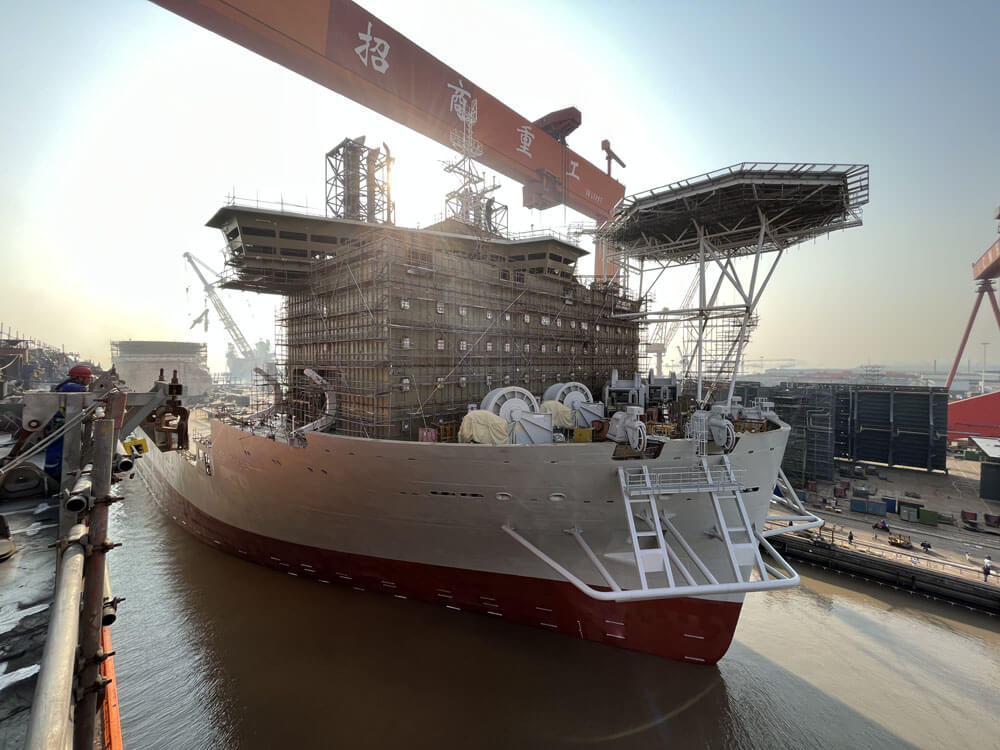Next Generation Offshore Wind Installation Vessel Launched in China

The global growth plans for offshore wind farms along with the increasing size of wind turbines and the other elements of the farms are spurring on the development of a new generation of wind installation vessels. These vessels are the first of a generation of innovative ships that are designed to increase the efficiency of the installation process as well as handle the larger elements for the new wind farms.
China’s CMHI Haimen shipyard marked a key milestone earlier this week in the development of these new wind installation vessels. The yard completed the float out of the Les Alizés, a hybrid offshore installation vessel being built for Belgium’s Jan De Nul group. The 61,000 dwt vessel will be the largest heavy lift vessel in the company’s fleet, able to install large offshore wind components, in floating conditions and with ultra-low emissions.
The launch started on January 2, by flooding the dry dock in which the Les Alizés was built. Once afloat, Les Alizés was moored alongside the adjacent quay wall for the final phase of the vessel’s construction, followed by sea trials. The Les Alizés is due for delivery in the second half of 2022 and is already reserved for her first assignment, which will be in Germany. She will be transporting and installing 107 monopile foundations for the construction of Gode Wind 3 and Borkum Riffgrund 3 offshore wind farms being developed for Ørsted.
“The construction of our offshore floating installation vessel Les Alizés is well on track,” said Philippe Hutse, Director Offshore Division at Jan De Nul Group. “Together with our offshore jack-up installation vessel Voltaire, which is also under construction in China, we will have the perfect set of offshore installation vessels that will be able to install current and future generations of offshore wind farms."

Floated for the first time this week in China (Jan De Nul)
Ordered at the end of 2019, the design of the Les Alizés exemplifies the next generation of wind farm vessel. Among the unique features is one of the largest cranes in its class which also employs an innovative Universal Quick Connector which they say will both improve the safety and efficiency of the lifting operations. It also has a motion-compensated electric pile gripper with an integrated guidance and survey system. The fully automated monopile handling system consists of a set of cradles, a skidding system, and an upending hinge that can handle and install XXL monopiles even in challenging weather and high sea conditions.
The Les Alizés is also an ultra-low emission vessel that combines diesel-driven generators with battery and drive technology to optimize engine loading and to recover the potential energy returned from the heavy-lift crane. The vessel, which can run on second-generation biodiesel is equipped with a dual exhaust filter system. According to Jan De Nul, the Les Alizés and Voltaire will be “the first two seaworthy installation vessels in the world with extremely low emissions.”
The company said it took into consideration that the new generation of turbines can be more than 855 feet high, with blades up to nearly 400 feet long, and sit on foundations up to 2,500 tons in designing its new vessels. The main features of the vessel which is approximately 777 feet long are the main crane with a lifting capacity of 5,000 tons, a deck loading capacity of 61,000 tons, and a deck space of 9,300 m². The vessel has accommodations for up to 150 people.
